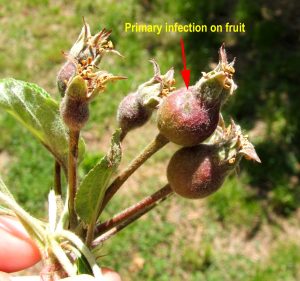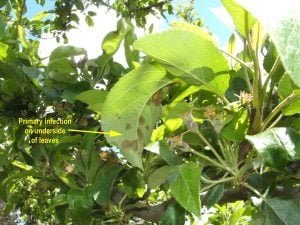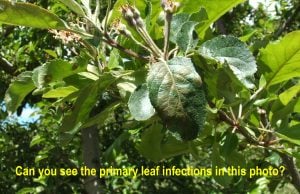Black spot otherwise known as apple and pear scab (caused by the fungal pathogens Venturia inequalis and V.pirina), survives through Winter as spore bodies mostly on fallen leaves under your trees. In pears, the disease might also overwinter on infected shoots. In Spring during rainfall events, these spore bodies release mature ascospores that settle on leaves, fruit and shoots to cause Primary infections. Spring fungicide spray programs aim to protect against the germination of these spores, thereby preventing primary infections. If your primary infection protective spray program is successful, the potential for secondary infections through the remainder of the season is significantly reduced.
In most districts, primary (overwintering) ascospore release should be complete by around the end of November or the first week in December (provided there have been adequate conditions for spore release during the Spring). Late Spring and early Summer is a good time to intensively scout your apple and pear blocks to look for primary infections and determine the potential for secondary infection. Secondary infection through Summer and Autumn come from primary infections established in the tree that Spring.

Early primary infection lesions on apple fruit typically have a dull grey-green appearance (Photo: Kevin Dodds – NSW DPI)
Our suggested routine monitoring schedule recommends inspecting 5 trees across each block, looking closely for 1 minute for leaf infections and inspecting 100 fruit per tree for fruit infections. For a more intensive inspection at the end of the Primary spore release period, extend the time you spend in each block and consider increasing the number of fruit checked. The more intensive your inspection, the more confidence you will have in your observations.
A good tip for leaf inspection is to get under the backlit canopy and search for darker patches on leaves which may indicate an infection. Inspect suspect leaves more closely to confirm the presence of a scab lesion. When checking fruit, it’s worth rotating individual fruitlets as infection can sometimes be hidden from view.

Getting under the canopy so that foliage is backlit, can help you to find apple and pear scab leaf infections (Photo: Kevin Dodds – NSW DPI)
If an intensive inspection for scab carried out in late November or early-December indicates zero scab infections, this means your primary spray program has been very effective and you can consider reducing your fungicide spray program through the Summer months. Conversely, if your Spring / early-Summer scouting identifies the presence of primary infections on leaves or fruit, you will need to maintain a full protective fungicide spray program (particularly ahead of any wet periods) right through until harvest.
Happy scouting!
Article reviewed by David Williams (Agriculture Victoria)

Can you see the primary leaf infections on the lower and upper leaf surfaces in this photo? (Photo: Kevin Dodds – NSW DPI)
